Thursday, November 28, 2013
Wednesday, November 20, 2013
Mercedes-Benz AMG Vision Gran Turismo
 For
the new PlayStation® 3 racing game Gran Turismo® 6, the Mercedes-Benz
designers have developed the visionary concept of a super sports car
– the Mercedes-Benz AMG Vision Gran Turismo. Extreme proportions,
sensual contours and intelligently implemented high tech blend to form a
body that visually brings to life the breathtaking performance of 430
kW (585 hp) and 800 Nm of torque. As a 1:1-scale model, the
Mercedes-Benz AMG Vision Gran Turismo is celebrating its world premiere
on 19 November 2013 at the opening of the new Mercedes-Benz Research
& Development Center in Sunnyvale, California. The super sports car
withwîth its hallmark Mercedes gullwing doors will be taking to the virtual
racetrack when the new racing game goes on sale in December 2013 – as
the first of the 'Vision Gran Turismo' series of vehicles.
For
the new PlayStation® 3 racing game Gran Turismo® 6, the Mercedes-Benz
designers have developed the visionary concept of a super sports car
– the Mercedes-Benz AMG Vision Gran Turismo. Extreme proportions,
sensual contours and intelligently implemented high tech blend to form a
body that visually brings to life the breathtaking performance of 430
kW (585 hp) and 800 Nm of torque. As a 1:1-scale model, the
Mercedes-Benz AMG Vision Gran Turismo is celebrating its world premiere
on 19 November 2013 at the opening of the new Mercedes-Benz Research
& Development Center in Sunnyvale, California. The super sports car
withwîth its hallmark Mercedes gullwing doors will be taking to the virtual
racetrack when the new racing game goes on sale in December 2013 – as
the first of the 'Vision Gran Turismo' series of vehicles.
To mark the 15th birthday of the popular Gran Turismo® series this year, Kazunori Yamauchi, Producer of Gran Turismo series and President of Polyphony Digital Inc., called upon the world's leading automotive manufacturers and design studios to look forward into the future. Úsing the theme 'Vision Gran Turismo', these creative teams were to develop concept models which give a unique insight into the further development of the automobile. As virtual vehicles that nonetheless function just like a real car, the visionary concepts will be gradually unveiled in and integrated into the new game Gran Turismo® 6 through online updates.
Extreme proportions and variable LED radiator grille
 'By
virtue of its proportions and expressive appearance, the Mercedes-Benz
AMG Vision Gran Turismo embodies the brand's defining design philosophy
of sensual purity in a unique way. The design of this concept car
reflects to extreme effect the perfect symbiosis between emotional,
sensuous contours and intelligently presented high tech,' says Gorden
Wagener, Vice President Design Daimler AG.
'By
virtue of its proportions and expressive appearance, the Mercedes-Benz
AMG Vision Gran Turismo embodies the brand's defining design philosophy
of sensual purity in a unique way. The design of this concept car
reflects to extreme effect the perfect symbiosis between emotional,
sensuous contours and intelligently presented high tech,' says Gorden
Wagener, Vice President Design Daimler AG.The sports car proportions that are a typical Mercedes feature have been reinterpreted: the long bonnet has a flowing transition into a compact greenhouse offset to the rear, which takes the form of an aerodynamically efficient water drop to descend slightly at the rear, where it rests on the rear end with broad shoulder contours. The dynamic aura is accentuated by an extended, dramatic side contour and a pronounced bulge to the wheel arches, which blend into the low-slung, muscular bodyshell. The angled headlamps, wîth their colour scheme and determined look, convey a sense of sportiness and readiness to leap forward. This impression is reinforced by the bonnet with its expressive forms and motorsport details, such as the release catches on the bonnet and the fuel cap, for example. The red-glowing contour lines on the lower part of the vehicle create an effect similar to that of exterior ambient lighting and stand out from the silver-painted bodywork. This makes the Mercedes-Benz AMG Vision Gran Turismo look even more aggressive.

Another eye-catching feature is the radiator grille – a reinterpretation of the wide Mercedes-Benz sports car grille with central star. Its shape is reminiscent of the legendary 300 SL racing car of 1952. However, instead of classic louvers the grille of the show car features exclusively LED's. The variable LED grille with different light patterns is a further development of the diamond grille introduced with the new A-Class.
Purist interior dedicated to speed
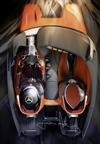 The
exterior design, which is systematically and passionately geared to
motor racing, is congenially mirrored in the interior of the two-seater.
Inspired by the Formula 1 cockpit, the red integral sports seats blend
into the black flooring of the foot well to form a protective shell. The
form of this flowing, sculptured shell suggests enormous forward thrust.
The dashboard also creates an equally dynamic effect. It has been
designed in the form of two gull wing doors which are positioned on each
side of the steering column. As a result the actual doors themselves
appear to be an extension of the instrument panel.
The
exterior design, which is systematically and passionately geared to
motor racing, is congenially mirrored in the interior of the two-seater.
Inspired by the Formula 1 cockpit, the red integral sports seats blend
into the black flooring of the foot well to form a protective shell. The
form of this flowing, sculptured shell suggests enormous forward thrust.
The dashboard also creates an equally dynamic effect. It has been
designed in the form of two gull wing doors which are positioned on each
side of the steering column. As a result the actual doors themselves
appear to be an extension of the instrument panel.The central display is optimally positioned in the driver's field of vision: it takes the form of a glass surface floating directly above the racing steering wheel with its shift paddles, and shows all the relevant information such as road speed, engine speed and operating temperature as required. Operation is by rocker switches in the center of the dashboard and in an overhead console, like in a jet. The steering column visibly penetrates the firewall to the engine compartment, creating a visual connection between the driver and the heart of this super sports car, the AMG V8 front-mid engine.
Intelligent lightweight construction and authentic racing car sound
The AMG V8 biturbo engine delivers an exceptionally agile response to even the smallest movements of the accelerator. It develops 430 kW (585 hp) and a maximum torque of 800 Nm. With an aluminum space frame body and components in carbon fiber, the material of choice in motor racing, the Mercedes-Benz AMG Vision Gran Turismo tips the scales at only 1385 kilograms. That amounts to around 2.4 kilograms per hp – an unrivaled figure in the super sports car segment, and one that guarantees exceptionally dynamic performance. Excellent deceleration values and fade resistance at the highest level are ensured by the AMG ceramic high-performance composite braking system. The AMG sports exhaust system with eight tailpipes integrated into the rear end provides a powerful accompaniment whenever the car accelerates, and ensures an unrivaled motorsports sound experience. For fans of Gran Turismo® 6, the Mercedes-AMG sound specialists have created a powerful, sonorous exhaust note that authentically celebrates the V8's love of high engine speeds.
Source - Mercedes-Benz
Thursday, November 7, 2013
Bay to Birdwood 2010

Click Here to check out my friends photo's of vintage cars in Australia.
Source: gawler.homestead.com
Wednesday, November 6, 2013
1965 Chevrolet Turbo Titan III
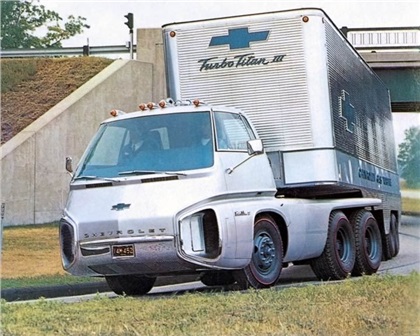
GMC Turbo Titan III

Inside, "Astronaut Seats" with full headrests were mounted on each side of a center console. A wing-topped handle controlling the six-speed automatic transmission was mounted on the console. Full interior carpeting was included along with retractable seatbelts, air-operated windshield wipers, full tinted glass, and air conditioning/warm air heating. A four-speaker FM stereo radio and a two-way telephone were used for the first time.

The most novel feature, though, was the GM designed and engineered "dial steering system." This unit was mounted on a pedestal in front of the driver, replacing the conventional steering column and wheel. Twin dials mounted on a padded vinyl panel operated the platforms power steering. An auxiliary pump driven from the propeller shaft provided emergency usage if the main pump failed for any reason when the platform was in motion. The automatic transmission quadrant was also mounted on this panel along with the turn signals. The pedestal pivoted forward and back along with the panel for the most comfortable driving position.

Chevrolet Turbo Titan III, 1965 - Magazine Ad
Source: sporttruck.com
1956 Chevrolet SR-2
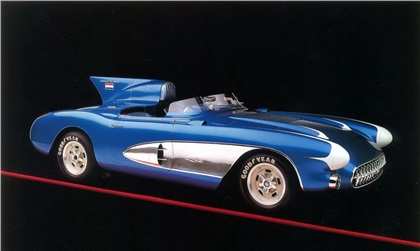
A stock Vette with a longer nose, side scoops, and a
dorsal fin, the SR-2 was raced by Harley Earl’s son Jerry and used to
prove out heavy-duty components later offered on production cars. It was
banished from the show circuit when the Big Three swore off racing.
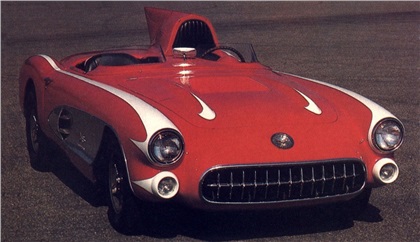
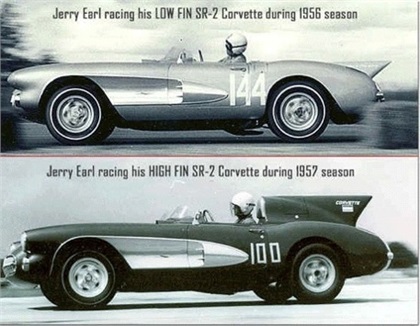
When Jerry Earl announced he was going to race a Ferrari 250 MM, his father, Harley Earl, commissioned a racing Corvette for him instead. Chevy already had the 1956 Sebring Racers, but Harvey Earl had his designers create a hotter looking Corvette for his son to race. The result was the very first Corvette SR-2.
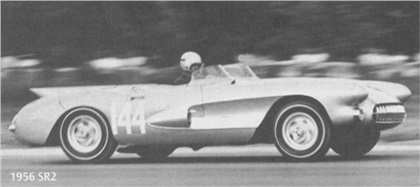
This “low fin” design had a rear fin that had the same height as the top of the rear deck. It also had a longer nose as the standard Corvette, fairing cones for the headlamps, fog lights in place of turn signals and air scoops at the end of the body side cove. William L. Mitchell had an SR-2 built with a taller fin integrated into a Jaguar D-type style of headrest. Notice the Corvette logo on the tail fin!
Source: carstyling.ru
1956 Chevrolet Impala Show Car

On July of 1955, the Chevrolet design studio staff create a dream car for the 1956 GM Motorama shows, called Corvette Impala. The Corvette grille and grille surround are incorporated, as well as other Corvette components. This hardtop five-passenger sports sedan shows the name "Corvette Impala" on the front emblem and rear license plate. On January 19 of 1956 the Motorama show opens in the Waldorf Astoria in New York City, running for nine days. The 1956 Corvette makes its debut and the Corvette Impala show car is displayed.

Chevrolet Impala Show Car, 1956
Source: shorey.net
1954 Chevrolet Corvette Convertible Coupe
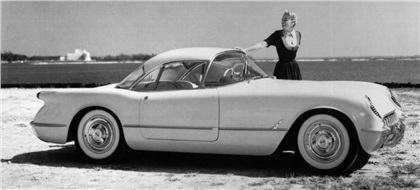
Corvette Hardtop Motorama Showcar, 1954
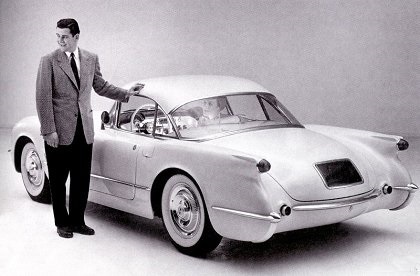
The Corvette Convertible Coupe was the closest in styling to the production model. It was painted in a muted yellow hue and it’s main distinctive was a fiberglass removable hardtop that gave the sports car new ”all-weather utility” as touted in the Motorama brochure. This feature would appear on production models as an aftermarket accessories beginning in 1955 and would officially become an option for the 1956 model year.
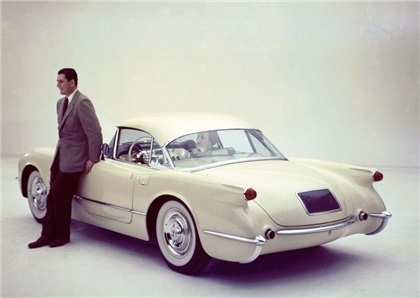

The hardtop feature would not become available until 1956. It took General Motors and Chevrolet three years to figure out that the consumer wanted roll up windows, outside door handles and door locks.

Like the 1954 Chevy Corvette Corvair and 1954 Chevy Corvette Nomad only the Chevrolet Corvette Hardtop Motorama Experimental Show Cars were made. How many? No one really knows.
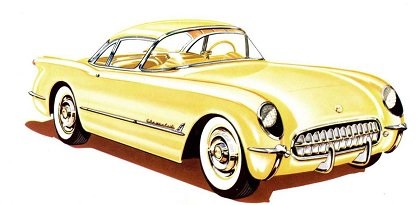
Chevrolet Corvette Convertible Coupe, 1954 - Rendering
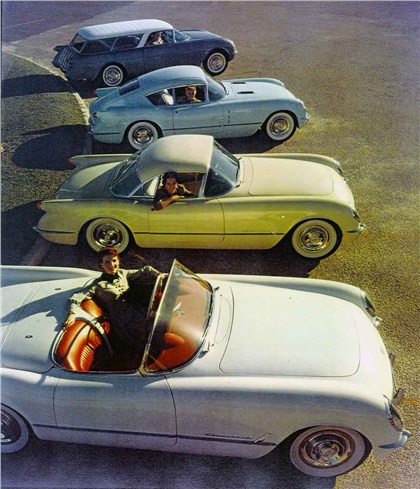
Three Corvette-based show cars were among the attractions of the 1954 GM
Motorama. From background to foreground are the Nomad, Corvair, and the
prototype hardtop car. The latter featured a detachable hardtop and
roll-up windows; both features would be adopted for the 1956 Corvette.
The white Corvette is a production model.
Source: shorey.net
1954 Chevrolet Corvair
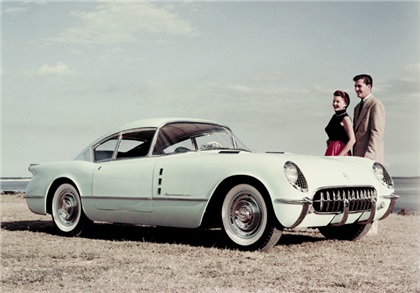
Corvair fastback coupe

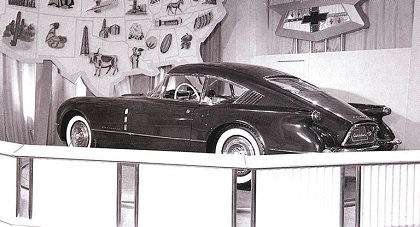
The roof was also interesting in a couple of other ways. First, it gave a glimpse of the quarter window and C-pillar treatment of the 1958 Chevrolet line, much like the Biscayne did a year later. Secondly, the addition of a fastback roof did not alter the Corvair’s interior layout. One would have expected that it would have had a finished-off cargo area, perhaps even equipped with fitted luggage, as was a common practice with sports cars at the time. Instead, the body appeared to have the roof grafted right on to a production Corvette, as there is no storage area behind the seats. The stock trunk area is used with a decklid contoured to the new roofline. The seats had the production fiberglass divider between them, just like a stock Corvette roadster. The area is even body-colored, which actually makes for a very attractive, albeit unusual interior layout for a closed coupe. The remainder of the interior is largely stock, with custom white seat covers and chromed interior C-pillar trim pieces.
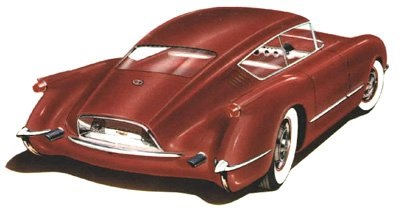
Chevrolet Corvair, 1954 - Rendering
Unfortunately for this particular machine, it was the only one of the three that did not reach production in some form. With Corvette sales becoming sluggish during the 1954 model year, it was seen by product planners as too high a gamble. The time for a Corvette fastback eventually did come, though nearly a decade later and on a new-generation machine.
Unfortunately for this particular machine, it was the only one of the three that did not reach production in some form. With Corvette sales becoming sluggish during the 1954 model year, it was seen by product planners as too high a gamble. The time for a Corvette fastback eventually did come, though nearly a decade later and on a new-generation machine.
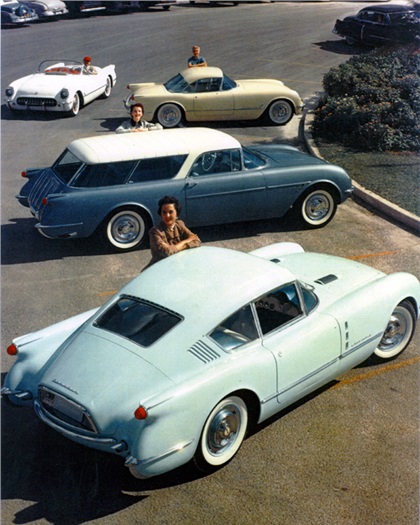
Corvette show cars: Convertible, Coupe, Nomad wagon, Corvair fastback coupe (1954)
Source: shorey.net
1955 Chevrolet Biscayne
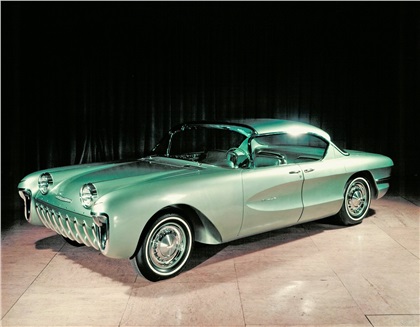
1955 Chevrolet Biscayne XP-37 (Designer - Chuck Jordan)
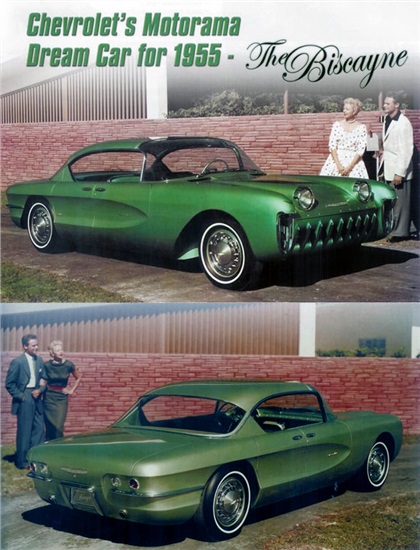
The engines is an experimental high compression Chevrolet V8 of 215 HP with dual exhaust, four barrel carburetor and high lift cam.
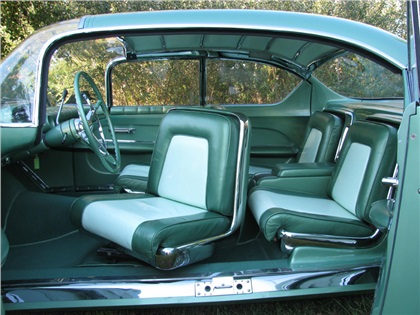
Chevrolet Biscayne, 1955 - Photo: Marty Martino
Source: autoweteran.gower.pl
1954 Chevrolet Nomad

Nomad station wagon


Corvette show cars: Convertible, Coupe, Nomad wagon, Corvair fastback coupe (1954)

Corvette show cars: Corvair fastback coupe, Convertible, Nomad wagon, Coupe (1954)
Source: shorey.net
1964 Chevrolet Chevy II Super Nova
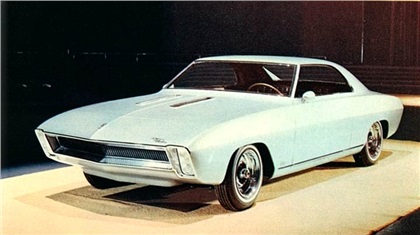
Chevrolet Chevy II Super Nova, 1964 - Show car is thought by some to look like a baby riviera, possibly a hint at what Chevrolet has up its sleeve to counteract Mustang boom.
Chevy II Super Nova 'Shark' Show Car
On the auto show circuit for 1964, this crisp-looking concept represented Chevrolet’s take on the future of sporty compact transportation, “Shark” style.
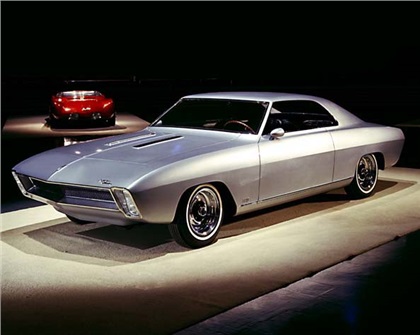
The Chevrolet Super Nova concept, nicknamed Shark, reportedly rode on the same 110-inch wheelbase as the same-year production Chevy II.
If you’ve never seen or heard of this car, there’s good reason: Ford’s fabulously popular Mustang hit showrooms at virtually the same time the Shark began making the auto show rounds. The poor Shark literally drowned in all the buzz surrounding the new Ford.

It wasn’t a fair fight, really. One sporty compact car was named for a horse; the other—a fish.
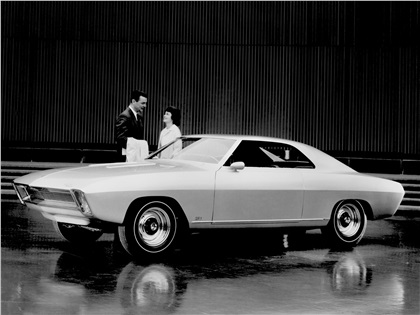
THE IDEA CAR has become a tradition with American automakers as a place to try out advanced and different styling concepts, component designs, and control refinements. Should such a dream puff excite public interest in the current vehicle which serves as its basis, so much the better. Chevrolet has unveiled its latest, built around the sturdy Chevy II, which it calls the Super Nova. Its fiberglass body, finished in "fire frost" silver, has a sloping 7.5-in extension of the hood and a bobbed tail on the same 110-in. wheelbase. The casual observer might see a hint of Riviera from the side. Normal door handles, both inside and out, have been eliminated from the car by putting an electric solenoid switch flush with the chrome window molding on each door. The windshield has a 60" rake and curved side glass extends to the pillar, eliminating vent windows. Minimum trim consisting of a rocker panel strip and different wheel covers and tires are used. Beneath the drooping snoot is a finely tooled grill, deeply recessed into a crisp well of bright metal. A pair of rectangular headlights, mounted vertically, flank the grill opening and are integrated into the surrounding casting, which serves in place of a bumper. Three large dials, fitted in individual pods hanging under the dash lip, are the only instruments before the driver. In addition to the 160-mph speedometer and 8000-rpm recording tachometer, there is a novel "Elometer" (elapsed time meter, in seconds). All other instruments and radio are lined up down the central panel from dash to console, with all window lift and other control switches aligned along the latter. Dual turn signal levers are installed behind the custom steering wheel, but are designed to turn with the wheel so as to always remain hidden behind the wheel spokes. The all-black interior is trimmed in a combination of leather, vinyl and polyurethane. At the rear, the stylists have come up with an awkward combination of styling clichés. The recessed rear window is an attempted adaptation from Porsche and Ferrari racing cars, the four rear lights are buried under the deck lip in separate holes and exhaust pipe tips form sides of the license plate cover. In all, it's an interesting version of a fastback snowplow.
Source: Car Life, July 1964
Subscribe to:
Posts (Atom)

